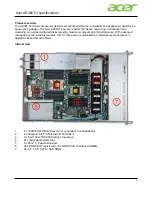
Installing the SUSE Linux Enterprise Server 12.2 operating system
This topic provides instructions on installing the SUSE Linux Enterprise Server 12.2 operating system (x64).
To install the SUSE Linux Enterprise Server 12.2 operating system (x64), do the following:
1. Insert the operating system installation disc into the optical drive that you have set as the first startup
device, and start the server from the optical drive.
2. Select
Installation
and configure the network settings. The following steps are based on the scenario
that
No
is selected in this step.
3. Click
OK
. In the “Language, Keyboard and License Agreement” window, select your language and
keyboard layout and then select
I Agree to the License Terms
. Click
Next
.
4. In the Network Settings window, configure the network settings and click
Next
. The following steps are
based on the scenario that default options are selected in this step.
5. In the Registration window, configure the information as prompted and click
Next
. The following steps
are based on the scenario that
Skip Registration
is selected in this step. Select
OK
in the Warning
window.
6. In the Add On Product window, select add-ons to be installed and click
Next
. The following steps are
based on the scenario that default options are selected in this step.
7. In the System Role window, select
Default System
and then select
Next
.
8. In the Suggested Partitioning window, use the suggested partitioning method and click
Next
. If you want
to create a drive partition, do one of the following:
• Manually create a root partition (/)
a. Click
Create Partition Setup
and select
Custom Partitioning (for experts)
. Click
Next
.
b. In the Expert Partitioner window, select
Hard Disks
from
System view
. Then select the disk (for
example,
sda
) for installing the operating system and click
Add
. Select the default partition type,
then click
Next
.
c. In the New Partitions Size window, select
Custom Size
.
d. Type the amount of space (for example, 80 GB) in the
Custom Size
field and then click
Next
.
e. Select
Operating System
from
Role
.
f. In the
Formatting Options
area, select
BtrFS
from the
File system
drop-down list box.
g. In the
Mount partition
area, select the forward slash
(/)
from the
Mount Point
drop-down list box.
h. Click
Finish
.
• Manually create a boot partition (/boot/efi)
a. In the Expert Partitioner window, select
Hard Disks
from
System view
. Then select the disk (for
example,
sda
) for installing the operating system and click
Add
. Select the default partition type,
then click
Next
.
b. In the New Partitions Size window, select
Custom Size
.
c. Type the amount of space (for example, 2 GB) in the
Custom Size
field and then click
Next
.
d. Select
Operating System
from
Role
.
e. In the
Formatting Options
area, select
FAT
from the
File System
drop-down list box.
f. In the
Mounting partition
area, select
/boot/efi
from the
Mount Point
drop-down list box.
g. Click
Finish
.
• Manually create a swap partition
74
ThinkServer TD350 Operating System Installation Guide
Содержание ThinkServer TD350
Страница 1: ...ThinkServer TD350 Operating System Installation Guide ...
Страница 6: ...iv ThinkServer TD350 Operating System Installation Guide ...
Страница 10: ...4 ThinkServer TD350 Operating System Installation Guide ...
Страница 66: ...60 ThinkServer TD350 Operating System Installation Guide ...
Страница 104: ...98 ThinkServer TD350 Operating System Installation Guide ...
Страница 121: ......
Страница 122: ......
















































